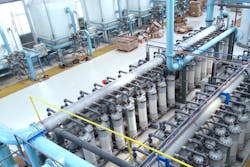3 key solutions for common industrial water treatment challenges
Modern industrial water treatment processes present a range of new challenges to increase efficiency and water sustainability with advanced system designs. Here we will review recent developments in ultrafiltration systems and chemical-free dissolved gas removal applications for corrosion control and ultrapure water.
1. Membrane contactors
Membrane contactors are compact and modular devices that control dissolved gases in liquids without chemicals. Removing the oxygen and carbon dioxide can reduce deterioration of boilers and piping due to corrosion. Chemical usage may also be reduced, which can decrease the blowdown frequency due to scaling from chemical deposits. Carbon dioxide removal can improve efficiency and reduces chemical consumption in mixed bed or electrodeionization applications.
3M Liqui-Cel Membrane Contactors are compact and modular devices that control dissolved gases in liquids without chemicals. They are capable of achieving < 1pbb O2 and < 1ppm CO2.
To learn more about the capabilities of 3M Liqui-Cel Membrane Contactors, watch the following video. For a case study on 3M Liqui-Cel Membrane Contactors in a customer application, click here. Also, you can visit 3M Separation & Purification Sciences Division at WEFTEC 2017, booth #5443.
3. Polyethersufone (PES)
PES hollow-fiber membranes provide a pronounced asymmetric structure that presents an outstanding relation of permeability and retention rate. This allows PES to achieve high volume flow at low transmembrane pressure and provide a unique way to reduce energy costs, particularly for larger filtration plants.
Throughout the module, the PES membrane is stabilized by its multifiber structure. Groups of hollow fiber membranes are interlaced with a robust yarn, which is potted together with the membranes. This provides additional mechanical strength for the hollow fiber in the axial direction, as well as during backflushing when the fibers can experience some flexing. At the same time, hydrodynamics during the backwash is improved as the yarn acts as a spacer between small bundles of hollow fiber membranes. This ensures better access for the flushing water to reach all areas of the membrane sections, even in the central area of a membrane segment. The modules utilize potted sealing instead of o-rings to prevent microbiological cross-contamination.
3M UltraPES Polyethersufone (PES) hollow fiber membrane provides a retentive layer on the inner side of the hollow fiber membrane. It exhibits an extremely hydrophilic characteristic, which reduces the potential of fouling. In addition, UltraPES shows a high caustic resistance and free chlorine tolerance, allowing 3M Liqui-Flux modules to operate at pH values between 1 and 13.
To learn more about the capabilities of UltraPES Polyethersufone (PES) hollow fiber membrane, watch the following video. Also, you can visit 3M Separation & Purification Sciences Division at WEFTEC 2017, booth #5443.
This content is sponsored by 3M Separation & Purification Sciences Division. Sponsored content is authorized by the client and does not necessarily reflect the views of the Process Flow Network editorial team.
